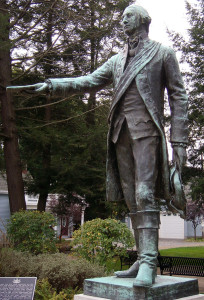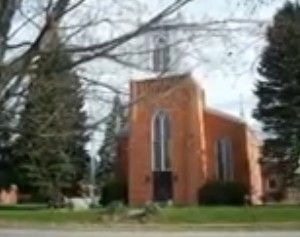Every town has its stories, legends, and place in history. Waterford is a small town in Northwest Pennsylvania where Friday night lights draw crowds for football,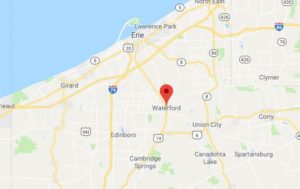 family names are generations old, men still gather at local coffee shops to swap stories, and a great place to live and raise a family. Once the home to French, British and American Forts, our location has drawn brave and industrious people since 1753. Plus, how many people can brag that George Washington really did sleep in our town when he visited the original Fort LeBoeuf in 1753.
family names are generations old, men still gather at local coffee shops to swap stories, and a great place to live and raise a family. Once the home to French, British and American Forts, our location has drawn brave and industrious people since 1753. Plus, how many people can brag that George Washington really did sleep in our town when he visited the original Fort LeBoeuf in 1753.
The Fort LeBoeuf Historical Society was originally formed in 1975 to 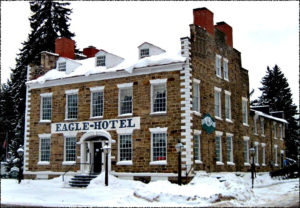 preserve the Eagle Hotel, which was in danger of being torn down. After much fundraising and hard work by many volunteers, the money was generated to purchase this historical building. The hotel now houses the Sugar ‘n Spice Restaurant on the first floor, plus museum rooms on the second floor. In time, the State turned other buildings over to the Historical Society, creating the Fort LeBoeuf Historical Campus at the south end of Waterford’s business district on Route 19. In addition to the Eagle Hotel, the Campus includes the Fort LeBoeuf French & Indian War Museum, Judson House, and George Washington Statue Park.
preserve the Eagle Hotel, which was in danger of being torn down. After much fundraising and hard work by many volunteers, the money was generated to purchase this historical building. The hotel now houses the Sugar ‘n Spice Restaurant on the first floor, plus museum rooms on the second floor. In time, the State turned other buildings over to the Historical Society, creating the Fort LeBoeuf Historical Campus at the south end of Waterford’s business district on Route 19. In addition to the Eagle Hotel, the Campus includes the Fort LeBoeuf French & Indian War Museum, Judson House, and George Washington Statue Park.
The Covered Bridge
About a mile and a half from town, Brotherton’s Bridge (also known as the Old Kissing Bridge), one of the three 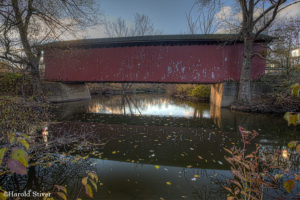 remaining covered bridges in Erie County crosses LeBoeuf Creek.The bridge is a 78 foot long and 15 foot wide Town lattice truss covered bridge. It was built in 1875 by Charles and James Phelps and was listed on the National Register of Historic Places on September 17, 1980. The bridge was documented by the Historic American Buildings Survey in 1936.It is the only Town lattice truss bridge in Erie County and one of only nineteen in Pennsylvania.The bridge was designed by Richard Cross using a Town lattice truss. The Town lattice truss was patented by Ithiel Town in 1832 and was used to make bridges with small, light pieces instead of large, heavy pieces that were more expensive to make. The bridge also has “an unusual, blue, metal pipe structure” on the exterior of the bridge’s south side supported with a king post framework.This is the only bridge that is painted in Erie County and has a sign hanging on the gable end of the portal saying “Old Kissing Bridge”.The bridge is located on Neimeyer Road (Old Wattsburg Road). From Route 19 in Waterford, turn onto East 1st Street. Turn right on East Street. East Street becomes Neimeyer Road. The bridge is located approximately one mile south.
remaining covered bridges in Erie County crosses LeBoeuf Creek.The bridge is a 78 foot long and 15 foot wide Town lattice truss covered bridge. It was built in 1875 by Charles and James Phelps and was listed on the National Register of Historic Places on September 17, 1980. The bridge was documented by the Historic American Buildings Survey in 1936.It is the only Town lattice truss bridge in Erie County and one of only nineteen in Pennsylvania.The bridge was designed by Richard Cross using a Town lattice truss. The Town lattice truss was patented by Ithiel Town in 1832 and was used to make bridges with small, light pieces instead of large, heavy pieces that were more expensive to make. The bridge also has “an unusual, blue, metal pipe structure” on the exterior of the bridge’s south side supported with a king post framework.This is the only bridge that is painted in Erie County and has a sign hanging on the gable end of the portal saying “Old Kissing Bridge”.The bridge is located on Neimeyer Road (Old Wattsburg Road). From Route 19 in Waterford, turn onto East 1st Street. Turn right on East Street. East Street becomes Neimeyer Road. The bridge is located approximately one mile south.
The George Washington Statue
In early 1753, Fort LeBoeuf was built by the French as part of a system of fortifications extending from the St. Lawrence to the Gulf of Mexico designed to help protect French interests in the Ohio Valley. That same year, George Washington, then a Major representing the Governor of Virginia, delivered a letter to the commander of Fort LeBoeuf warning the French to withdraw their forces from this region claimed by Great Britain. Six years later, the French withdrew their forces and burned the fort. The English took possession of the site and built a new fort in 1760, which was subsequently burned in 1763 by Indians during Pontiac’s rebellion. Wanting to memorialize Washington’s visit, the George Washington Monument was erected in 1922 by the citizens of Waterford, PA at a cost of $13,000. It was situated on the site of the original Fort LeBoeuf, which was in the middle of High Street between the Eagle Hotel and the historic Judson House. The monument was moved in 1945 to the lot beside the Eagle Hotel. What makes this monument unique? This is the only statue of Washington wearing a British uniform in Pennsylvania.
The Waterford Cemetery
The old cemetery at the southwest corner of Second and West streets was the only one in the borough until 1840, when the first part of the present cemetery was laid out by William Benson, Sr., under the auspices of the borough, containing one and a quarter acres. The first burial in the latter was that of a child of Dr. Banning, in December 1840. This section became completely filled up, and more ground being necessary the borough in 1865 deeded the property to the Waterford Cemetery company, who have increased it to eleven acres, at a cost of about $1,000 for the land. A part of the addition was laid out by Judge William Benson in 1865, and the balance by John H. Millar in 1875. The cemetery occupies dry, gravelly ground, on the side of the borough toward the depot, is well laid out, and contains numerous costly monuments.
Within the cemetery, in a full lot appropriated for the purpose by the company, used to lie the bones of Michael 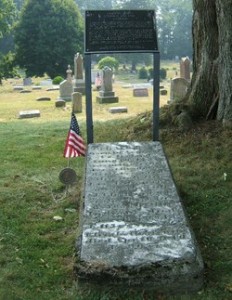 Hare, the oldest man who ever lived in Erie County and perhaps in Pennsylvania. Born in Ireland on the 10th of June 1727, and died in Waterford, after a long residence there, on May 3, 1843, at the almost incredible age of one hundred and fifteen years eight months and twenty-two days. Mr. Hare served in the French wars, was present at Braddock’s defeat, fought all through the Revolution, and wound up his military career by taking part in St. Clair’s expedition against the Western Indians. At St. Clair’s defeat, he was left on the field for dead and lost his scalp, which did not seem to cause him much inconvenience in after years. Mr. Hare was one of the first settlers of Wayne Township, from which he moved to Waterford. Besides Mr. Hare, two other Revolutionary soldiers are buried at Waterford — Capt. John Lytle and Neil McKay — and five soldiers of the last war with Great Britain — M. Himrod, H. Colt, James McKay, J. Benson and J. Lenox.
Hare, the oldest man who ever lived in Erie County and perhaps in Pennsylvania. Born in Ireland on the 10th of June 1727, and died in Waterford, after a long residence there, on May 3, 1843, at the almost incredible age of one hundred and fifteen years eight months and twenty-two days. Mr. Hare served in the French wars, was present at Braddock’s defeat, fought all through the Revolution, and wound up his military career by taking part in St. Clair’s expedition against the Western Indians. At St. Clair’s defeat, he was left on the field for dead and lost his scalp, which did not seem to cause him much inconvenience in after years. Mr. Hare was one of the first settlers of Wayne Township, from which he moved to Waterford. Besides Mr. Hare, two other Revolutionary soldiers are buried at Waterford — Capt. John Lytle and Neil McKay — and five soldiers of the last war with Great Britain — M. Himrod, H. Colt, James McKay, J. Benson and J. Lenox.
In early 1753, Fort LeBoeuf was built by the French as part of a system of fortifications extending from the St. Lawrence to the Gulf of Mexico designed to help protect French interests in the Ohio Valley. That same year, George Washington, then a Major representing the Governor of Virginia, delivered a letter to the commander of Fort LeBoeuf warning the French to withdraw their forces from this region claimed by Great Britain. Six years later, the French withdrew their forces and burned the fort. The English took possession of the site and built a new fort in 1760, which was subsequently burned in 1763 by Indians during Pontiac’s rebellion. Wanting to memorialize Washington’s visit, the George Washington Monument was erected in 1922 by the citizens of Waterford, PA at a cost of $13,000. It was situated upon the site of the original Fort LeBoeuf, which was in the middle of High Street between the Eagle Hotel and the historic Judson House. The monument was moved in 1945 to the lot beside the Eagle Hotel. What makes this monument unique? This is the only statue of Washington wearing a British uniform in Pennsylvania.
Other sights around Waterford
Covered Bridge (1875): 86-ft. wood lattice truss bridge built by brothers Charles and James Phelps
Episcopal Church (1832): One of the early baptisms to take place was that of Strong Vincent on December 31, 1837
The church is located at 100 East 3rd Street. This church serves the small community of Waterford with a total population around 1500. If you have the opportunity to visit the sanctuary you will discover the true beauty of the church. St. Peter’s is very involved in the community and participates in community-wide events such as the Waterford Days and Colonial Christmas.

Brotherton Inn (late 1700s)
Moved from the corner of 1st and Cherry Streets to where it sits today.
Judge John Vincent House
This house was the birthplace of his grandson, Strong Vincent, who is most known for his bravery at the Battle of Gettysburg.
In 1837, Strong Vincent was born in his grandfather’s house, the honorable Judge John Vincent, on the Northwest corner of East 1st and Cherry Street in the Borough of Waterford. The family moved to Erie in 1843. The judge every year always had the whole family return to his home for Christmas. A special Christmas tradition at his home was that all of the grandchildren would find a hundred dollar bill beneath their plates. According to the Vincent’s family journal, the children enjoyed playing hide and seek in the house, because at that time the house extended much farther north and all buildings were connected to the house, wood shed, livery and tack rooms, wood shop, and carriage houses, etc. that gave a lot of area’s to hide. The house burned down during the late 1990’s.
Strong Vincent (June 17, 1837 – July 7, 1863) was a lawyer who became famous as a U.S. Army officer during the fighting on Little Round Top at the American Civil War Battle of Gettysburg, where he was mortally wounded.
Vincent was born in his Grandfather’s home in Waterford, Pennsylvania, son of iron foundry-man B. B. Vincent and Sarah Ann Strong Vincent. His early education was obtained in the academy at Erie, where he spent two years in his father’s iron foundry, before attending Trinity College and Harvard University, graduating in 1859. While attending Trinity College in Hartford, Connecticut, He met and courted the young lady who would become his wife. Expelled for beating up a man who impugned his lady’s honor, Vincent enrolled at Harvard. He practiced law in Erie, Pennsylvania.
At the start of the Civil War, Vincent joined the Pennsylvania Militia as an adjutant and first lieutenant of the Erie Regiment. On September 14, 1861, he was commissioned lieutenant colonel of the 83rd Pennsylvania Infantry and was promoted to colonel the following June. After the death of his regimental commander in the Seven Days Battles (at the Battle of Gaines’s Mill), Vincent assumed command of the regiment. He developed malaria on the Virginia Peninsula and was on medical leave until the Battle of Fredericksburg in December 1862. On May 20, 1863, he assumed command of the 3rd Brigade, 1st Division, V Corps, Army of the Potomac, replacing his brigade commander, who was killed at the Battle of Chancellorsville.
At the Battle of Gettysburg, 26-year-old Vincent and his brigade arrived on July 2, 1863. He had started the Gettysburg Campaign knowing that his young wife, Elizabeth H. Carter, whom he had married on the day he enlisted in the army, was pregnant with their first child. He had written her, “If I fall, remember you have given your husband to the most righteous cause that ever widowed a woman.”
Strong Vincent is buried in the Erie Cemetery and is memorialized in Erie by a statue erected in 1997 at Blasco Memorial Library and in the naming of Strong Vincent High School.
 Waterford Masonic Building (1840s)
Waterford Masonic Building (1840s)
 Civil War Recruitment Building (c. 1823)
Civil War Recruitment Building (c. 1823)
Built in 1823, it was the recruitment center for the Pennsylvania 83rd regiment, Company E, during the Civil War.
The building, though historical in its significance, is not listed on the National Register of Historic Places listings in Erie County. Owned and maintained by a private owner, under the cover of darkness on a Monday morning on Labor Day in 2014 the owner removed and threw away all the architectural wood trim and ornamentation that defined the building’s period, then proceeded to cover the building entirely with vinyl siding, creating a modern facade.
During the civil war Waterford was the designated recruitment center for the surrounding area. The recruitment building, located on the east side of High Street between South park and East Second Streets was home to the Pennsylvania 83rd regiment, commonly called the 83rd Pennsylvania.
The 83rd Pennsylvania was a volunteer infantry regiment in the Union Army during the American Civil War. They participated in almost every major battle in the East, including Seven Days Battles, Antietam, Fredericksburg, Gettysburg, Petersburg and the Surrender. They alongside the 20th Maine, 44th New York and the 16th Michigan fought in the spirited defense of Little Round Top in which former regiment commander Colonel Strong Vincent, native of Waterford, was mortally wounded. The 83rd Pennsylvania suffered the second-highest number of battle deaths among Union Army infantry regiments during the war, behind only the 5th New Hampshire.
The regiment was mustered into United States service on September 8, 1861, then Mustered out June 28, 1865 after the war. During the war the Regiment lost during service 11 Officers and 271 Enlisted men killed and mortally wounded and 2 Officers and 151 Enlisted men by disease. Total 435.
 Burial Site of Old Frank, Civil War Horse
Burial Site of Old Frank, Civil War Horse
Civil War was devastating to the Waterford area. The 83rd (Company E) and 111th Regiments seemingly were always in the front of the action. Officers and men fell – 53% of the total enlisted men were casualties. In 1865, they were mustered out, finally able to return home. Colonel W. O. Colt returned and brought his Southern captive with him – Frank, a dapple – gray war horse.
Col. Colt and Frank were common sights around town. Frank had the run of the town, visiting lawns and gardens, where he selected only the best. Not everyone was pleased, but no magistrate would stop the practice. Even after twenty years, the War was still closely remembered.
On July 4, 1887, the community drew together to celebrate Independence Day. Col. Colt led the parade riding Old Frank. Someone fired a cannon. Frank fell to his knees, quivered for a few seconds, and fell over – dead. The trauma and memories had overcome him.
Many in town though he needed a proper burial, with military and religious overtures. The outraged parochial leaders were against it, but they could not stop the proceedings. A grave was dug in the park, behind third base. The local four piece brass band played, “Nearer My God to Thee” before an army chaplain read a eulogy. Frank was lowered into the grave, standing upright, with a sword strapped to his old army saddle and dozens of citizens filed past and dropped flowers into his final resting place.
Teary eyes and some sobs were common as the bugler played “Taps.” They buried more than a horse in Waterford that day.
The Waterford Hotel (1858)
Originally built as a private residence, it has been a hotel since the early 1900s.
It is said that the honorable Samuel Hutchins built what is now the Waterford Hotel at 213 High Street, Waterford, PA in the 1840’s as a private home. Samuel Hutchins was born in Vermont in 1787 and died in Waterford on February 8, 1868 at the age of 81. Samuel married, wife Sophia 1802-1851. They were laid to rest in the Waterford Cemetery.
From 1819 – 1820 Mr. Hutchins was the Waterford Post Master. He was also a store merchant in partnership with Amos Judson of Waterford from 1824 – 1847. They first ran a dry goods store on East 1st street between Cherry and Chestnut Streets. In the early 1830’s they had the three story brick building built on the northwest corner of West 1st and High Streets. The last business in that building was Joe’s Auto Parts, which is no longer there. In 1833 Samuel Hutchins held the office “Overseer of the Poor” in Waterford. He was a State Assembly-man from 1838 – 1839 and an Erie County Associate Judge from 1856 – 1861.
In the 1850 Erie County census, Samuel Hutchins was living in Waterford on the corner of East South Park Row and High Streets. Sixteen people were living on his property.
In the 1860 Erie County census, Samuel Hutchins was 73. The 2 other people living in his residence were Lucinda and Sophia (Samuel’s youngest daughter). Sophia later moved to Erie and married W.C. White in 1861. Samuel’s son Clinton and his wife lived in the house until their deaths. It was sold at a sheriff ’s sale in 1901 for $5,000.00 to a John and Eloise Phelps who made it into the Waterford Hotel. On November 5, 1903 it was sold to John and Margaret Henry. The Henrys’ daughter Evangline “Eva” Henry (1884-1971) married Waterford dentist, Dr. Raleigh Barnes (1884-1954) in the Hotel and it was said her veil flowed down the length of the front staircase. It was a such a fabulous wedding that it was talked about for a long time in Waterford.
The house/hotel was vacant for a few years in the 1890’s. I read when Dr. Theodore Barton’s big Victorian house at 29 South Park Row burned, Dr. Barton lived in the vacant house/ hotel for a short time. Someone told me a Blystone family lived in it a while as well. Blystone and Harrison Phelps Gillette were the names on the sheriff sale as “trustees” for the property, possibly because they were on the Waterford town council. Since the 1900’s it has had several owners and names, including the Camp Inn, the Green Goose Inn and the Lincoln Hotel. I went to the Erie County Courthouse and traced the owners from current back to the 1901 Sheriff ’s Sale. The “Wishart Papers” in the Waterford Library tell about the Hutchins family living in the house/hotel. The 1865 map census shows the Hutchins lived on the property as well.
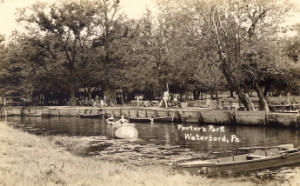 Lake LeBoeuf and Porter Park
Lake LeBoeuf and Porter Park
The lake was formed by the receding Wisconsin Glacier during the last ice age. It is 0.66 mile long by 0.5 mile wide.

Site of Philadelphia & Erie Railroad Station (1856)
Built one mile outside of town to appease residents who were leery of the noise the trains would cause
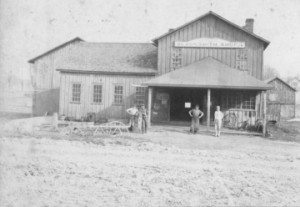 Hovis Blacksmith Shop
Hovis Blacksmith Shop
Operated by three generations from 1858 to 1920.
 Old Waterford Academy School (1822)
Old Waterford Academy School (1822)
We humans have great memories – we even remember thing that never happened! With time, uncomfortable events become romanticized and very real to us. Remember Grandma saying she walked four miles to school and back, how deep the snow was, how cold winters were, how mean the teachers were (at least to the boys), how you “really had to learn your lessons and not like now?” Most of these memories are rather pleasant nostalgia that add spice but not accuracy to the past. Central heating, insulated clothing, in-door plumbing, and warm school busses may have robbed the kids of today, cherished stories for their future grandchildren. But consider this; In 1884, there were 17 one-room schoolhouses in Waterford Township and one two-roomer. In LeBoeuf, there were 12 schoolhouses and in Summit there were 9. The Boards had done a good job distributing these schools geographically to the benefit of the children. Not many pupils walked four miles to an elementary school, in fact, not one!
The trustees hired Peter Ford of LeBoeuf Township to dig a well twenty-two feet deep and stone it. In the same year, 1821, the basement was dug for the building. The outside dimensions were 36′ by 48′. A quarry on Oak Hill, about five miles away toward Union City was opened, where sandstone was obtained. That fall and winter the stone was blasted, cut, and hauled on sleds and wagons to the building site. Though no records seem available today to prove the point, it is generally agreed that Thomas King and the two Scotsmen that built the Eagle Hotel, (both buildings were erected in the same years), also built the Academy. The work on the two buildings, experts agreed, was quite similar.
The Academy was built of sandstone. The basement was 7 feet high, 4 feet of which were above ground level. On this foundation set two levels of floors for classes and study. A striking cupola graced the roof. In all, it was as graceful a building as could be found anywhere west of the mountains. It was the first of its kind on the frontier. When the building was demolished in 1955, one hundred thirty years later, the windows and doors were still level and plumb.
In 1826, the Academy was ready to open. The first teacher was hired – he doubled as its first Principal. His name was John Wood; he was an English Civil Engineer, who worked for “the rate of $108.00 every 12 weeks.” There were twenty pupils. By 1829, an extra teacher was added to teach the forty students enrolled. By 1838, there were ninety pupils and they looked for and hired a teacher capable of “giving instruction in the Greek and Roman classics, mathematics, and the English Language.” Though a private academy, it was accepted as a public pride.
The Waterford Academy Directors were concerned that the public academy at Edinboro was showing great growth and in 1857 was poised to be a public college, as well as an academy. In March of 1858, they had an architect determine if an addition could be added to increase their classroom capacity. It could. Remove the stone outer wall of the east side from the second floor to the roof. Extend the upper floor outward for 20 feet. Make one very large assembly or recitation room and divide the first-floor area into two laboratory rooms. The work was begun at once and was complete for usage the next year. The measurements were 20′ by 34′, with a full basement. It provided much needed space.
As a public high school, Waterford began to change its curriculum to be “more in the times.” By 1901, they developed a program of study that included Agriculture, which combined class and field work. They had help and encouragement from Penn State. Waterford was the first “Agricultural” High School in America! In 1908, working with Waterford, Penn State developed a syllabus for teaching of Vocational Agriculture in schools, and in 1911, the State required the teaching of Ag in all rural areas.
In 1917, the Smith-Hughes Vocational Education Act provided federal funds to states to implement Vocational and Agricultural education. It also provided money for Home Economics to be taught. Waterford seized the opportunity and for approximately seventy years, these two programs were strong in the school. These graduates developed the skills to exert themselves in farming, home making, the allied industries, but also the professions. Many engineers, doctors, nurses, teachers, and others received the necessary “push” from these fine programs. Later, commercial subjects were supported by the federal government, which opened many jobs in the business world.
The need for an indoor athletic facility, as well as an assembly area was answered in 1931 by an addition, on the south side of the Old Academy. Bad concerts, plays, skits, “pep meetings,” town meetings, movies, and of course basketball games kept the place humming. Again, however, by the end of the war, increased enrollment and expectations mandated new facilities.
By the early 1950’s, Waterford Borough and Waterford Township were well established and comfortable with the political arrangement for directing the school. The State began pushing for better methods of consolidation. LeBoeuf and Mill Village had a good elementary tradition but were unsettled for post-elementary education. There were many who had questioned the need for a closer union with other districts for high school. Others realized the cultural heritage with the Waterford Area. When the LeBoeuf Board moved toward a jointure with Waterford to build a new high school at $900,000, some of the citizens entered into a lawsuit to stop the process. The year was 1952.
To still the dissent and also get community support for the necessity of moving forward on the path the State had provided, an informational meeting was held on February 12, 1952, at the high school auditorium. No better example of democracy in action can be found than on that night.
Mr. E. L. Heard, President of the Joint Board of twenty members presided. He gave an overview of the problem and the course of the night. He followed questions and comments yet kept order and civility. Mr. Lee Port, a gentleman farmer and member of the LeBoeuf Board, explained three problems:
1. Increased LeBoeuf school enrollment.
2. Lack of any other high school desiring their students.
3. A problem of non-reimbursed tuition costs if not members. (His conclusion: Best to be part of the jointure.)
Mr. M. E. Kolpein, the County Superintendent of Education, explained how the State would reimburse the districts if the jointure went forward. LeBoeuf and Mill Village would benefit more than enough to pay their rental obligations.
Mr. Willis McGinnett explained Mill Village’s position:
1. Need for a voice in policy at high school level.
2. Advantages of larger attendance and administrative unit.
3. Members of the individual Boards had assured Mill Village they would never lose their elementary school.
The meeting was concluded. It produced nearly complete agreement to go forward. Woe be to anyone who might forget Mr. McGinnett’s third point.
The legal case against Le Boeuf School Directors was dropped. When the building was torn down in 1955, the windows and doors were still plumb.
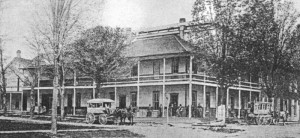 Site of the Park House/Opera House (1882)
Site of the Park House/Opera House (1882)
Once stretching the entire block, the Park Opera House hosted many lavish parties. It also operated its own horse-drawn taxi service which transported visitors from the train station to town.
The Park House was located on High Street between North Park Row and West 4th Street where the Atlantic Gas station stood and the Stancliff House Company now stands. Although I cannot find out why it was torn down in 1922, I believe it was because it was gutted by fire.
It was a hotel with a dining room and a livery. In 1910 it was operated by Cap Maurer. Cap later had the Gulf Gas Station that was located between 6th and 7th Streets on High Street.
The Park house was owned by the Stancliff’s. They bought the first fire truck for Waterford, hence, the Stancliff Hose Company. They also built the house on the corner of 5th and Cherry Streets. The elevator in the house was built because Mrs. Stancliff was handicapped.
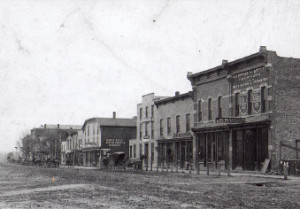 The High Street Block from West 1st Street to West 2nd Street burnt twice during the 19th century, March 1865 and March 1895
The High Street Block from West 1st Street to West 2nd Street burnt twice during the 19th century, March 1865 and March 1895
Historically, March has not been a good month for Waterford. Two devastating fires nearly destroyed the town back in the 1800’s. On March 5, 1865, (just about six weeks before President Lincoln’s assassination, to put it in perspective), fire erupted in one of the stores on the west side of High Street. It consumed almost all the buildings between 1st and 2nd Streets. The cause of the fire has been lost in the depths of antiquity.
Of course, the buildings that were lost were replace with wooden-frame buildings, the same as their predecessors.
Almost 30 years later in the wee hours of the morning of March 3, 1895, fire broke out again in the same area.
The fire originated when someone in preparing a coal stove for the night, carelessly discarded some hot ashes. Within a few hours, the ashes ignited the building.
The fire spread in both directions and jumped 2nd Alley. In a few hours, all of the buildings between 1st and 2nd Streets were burned to the ground!
The fire was fought largely by bucket-brigade.
Beginning at 1st Street, the businesses lost were:
Ensworth Hardware
Benson’s Bank
Cook’s Shoe Store
Phelps’ Meat Market (Where the fire started.)
Nickles & McClure Feed Store
Hull’s Grocery
(2nd Alley)
Drugstore
Judson Millinery
Phillips’ Barber Shop
Johnson Jewelry
Benson Meat Market
Whitney Grocery
Ward’s Millinery
Patten’s Grocery
That is a total of 14 stores that were reduced to ashes, and the dollar-loss was placed at $50,000! Miraculously, there was no loss of life nor serious injury.
On March 11, the town council passed an ordinance prohibiting wooden buildings in the business district.
The first store rebuilt opened in April, and what seems to me most amazing, the rest of the buildings were up and running by mid-November! They are the stores we see in Waterford today.
 Site of Salt Warehouses
Site of Salt Warehouses
In early 1800s several warehouses were built along the inlet and outlet of Lake LeBoeuf. Salt was shipped to Pittsburgh on flat boats or keel boats, while goods for domestic use or the 1812 wartime effort were shipped from Pittsburgh to Waterford. Site of War of 1812 Munitions Arsenal.
